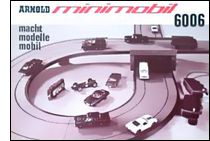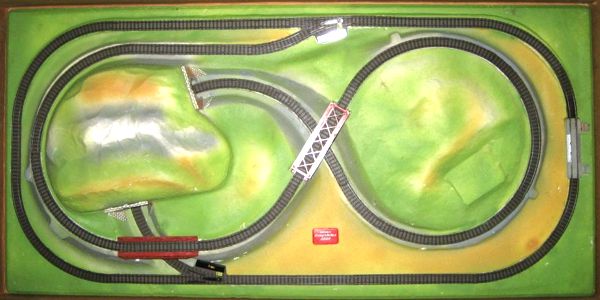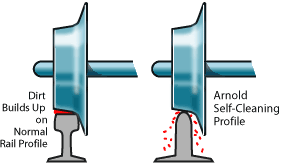Company Profile: Arnold
History in a Nutshell
![]() K. Arnold GmbH & Co., founded by Karl
Arnold in 1906 in Nürnberg, Germany, originally manufactured tinplate toys. During World War II, all Nürnberg production
sites were destroyed; production was resumed after the war in their Upper Palatinate Mühlhausen branch until the Nürnberg plant was rebuilt. Due to
the gradual decline in sales of tinplate toys, in the late 1950s Arnold shifted its product focus to something quite different, and in 1960 they
introduced their Rapido 200 train line—with a scale of 1:200 and 8.5 mm gauge track—at the
Nürnberg International Toy Fair.
K. Arnold GmbH & Co., founded by Karl
Arnold in 1906 in Nürnberg, Germany, originally manufactured tinplate toys. During World War II, all Nürnberg production
sites were destroyed; production was resumed after the war in their Upper Palatinate Mühlhausen branch until the Nürnberg plant was rebuilt. Due to
the gradual decline in sales of tinplate toys, in the late 1950s Arnold shifted its product focus to something quite different, and in 1960 they
introduced their Rapido 200 train line—with a scale of 1:200 and 8.5 mm gauge track—at the
Nürnberg International Toy Fair.
 The products were quite crude and lacked automatic
couplers, something even Lone Star's Treble-0-Trains had. Undaunted, by 1962 Arnold had reengineered the entire
line, bumping the published scale up to 1:160 and the track gauge to 9 mm. Then, a year later, they adapted an automatic coupler design from Rokal,
a leading manufacturer of TT Scale at the time. But the boldest move what to license their coupler to other N Scale manufacturers, which was
actually recommended by
American consultant Ted Brandon. The "Rapido coupler" was adopted by the
MOROP European standards in 1964.
The products were quite crude and lacked automatic
couplers, something even Lone Star's Treble-0-Trains had. Undaunted, by 1962 Arnold had reengineered the entire
line, bumping the published scale up to 1:160 and the track gauge to 9 mm. Then, a year later, they adapted an automatic coupler design from Rokal,
a leading manufacturer of TT Scale at the time. But the boldest move what to license their coupler to other N Scale manufacturers, which was
actually recommended by
American consultant Ted Brandon. The "Rapido coupler" was adopted by the
MOROP European standards in 1964.
But Arnold faced an uphill battle. Their manufacturing capabilities lagged behind those of competitive manufacturers such as Trix, who had entered the N Scale market in 1964 with technically and aesthetically superior products. Arnold frequently received generally unfavorable product reviews with respect to fidelity and locomotive performance, although their work with Ted Brandon in the early 1960s, as well as Revell beginning in 1967, helped address some of these issues, and also resulted in the production of more and better North American models. Arnold also acquired the plastic structure kit line from KleiWe in 1971.
 One of Arnold's rare non-railroad, non-N Scale products
was an unusual slot car system from the 1960s. Called Minimobil, it made Matchbox (or any similarly-sized, free-rolling) vehicles move along a track by
means of a continuous wire spring running beneath the roadway surface; consequently, all of the cars placed on the track moved together.
Lesney Products later licensed the system from Arnold for sale
in the US under the name Matchbox Motorway. You can see one running here.
One of Arnold's rare non-railroad, non-N Scale products
was an unusual slot car system from the 1960s. Called Minimobil, it made Matchbox (or any similarly-sized, free-rolling) vehicles move along a track by
means of a continuous wire spring running beneath the roadway surface; consequently, all of the cars placed on the track moved together.
Lesney Products later licensed the system from Arnold for sale
in the US under the name Matchbox Motorway. You can see one running here.
![]() Arnold managed to remain competitive in the scale it invented,
for all intents and purposes, until 1995, when they filed for bankruptcy and was acquired by Rivarossi. But Rivarossi was already
having problems of their own thanks to AHM, and they were insolvent by 2003, at which point
Hornby acquired them. Thus, Arnold Rapido trains (not to be confused with
Rapido Trains) remain available.
Arnold managed to remain competitive in the scale it invented,
for all intents and purposes, until 1995, when they filed for bankruptcy and was acquired by Rivarossi. But Rivarossi was already
having problems of their own thanks to AHM, and they were insolvent by 2003, at which point
Hornby acquired them. Thus, Arnold Rapido trains (not to be confused with
Rapido Trains) remain available.
N Scale Products
Although Arnold's original Rapido 200 line was claimed to be 1:200, the models actually scaled out to very slightly larger than 1:160 (but they're so crude that it's a bit pointless to bother determining their exact scale). Interestingly, Arnold produced a proportionately larger number of North American models than most other European manufacturers at the time. Indeed, they were printing leaflets in English and offering "Special American" train sets since 1962; clearly they had their eye on the US market from the beginning, and Charles C. Merzbach helped. (More images.)
They'd even made a ready-to-run layout for the Rapido 200 line.

Arnold's couplers went through three phases. Initially (1960) they were C-shaped steel hooks that would couple on their own but could not be remotely uncoupled. When they adopted the Rokal design (1963), the new coupler had pins protruding from the top to provide backwards-compatibility with the steel C hooks. Finally, they dropped the pins (1964) and settled on the design we know today. Also, the locomotives originally ran on 6 VDC; when Arnold retooled the line in 1962, they increased the voltage to 12.
Arnold track was made of steel, which rusted over time, and it was incompatible with everyone else's nickel-silver track, leading to confusion and frustration principally among North American customers. That said, the rail's unusual profile did offer a benefit:

Printed Matter
Arnold's products may not have been the very best on the market, but their catalogs and other marketing materials were nothing less than top-drawer—extensive, thorough and professional, with expertly-translated English-language text; their full-color 1968/69 catalog is a whopping 58 pages!
- Rapido 200 Layout Manual (front cover only)
- 1960 Catalog (front cover only)
- 1961/62 Catalog (front and back covers only)
- 1962/63 Catalog (front and back covers only)
- 1963/64 Catalog (French)
- 1966/67 US Leaflet
- 1966/67 US Catalog
- 1967/68 US Leaflet
- 1967/68 US Catalog
- 1968/69 US Catalog

